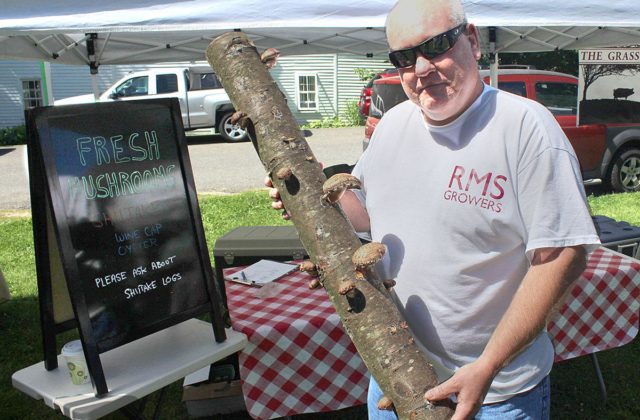Growing Shiitakes for Fun and Profit
By Wiley Wood
If you’ve come to the Norfolk Farmers Market looking for goat milk soap, French pastries, or zucchini blossoms, Andy Griffin’s stand is not for you. What he has is mushrooms, mostly shiitakes, which he sells by the pint or the half pint. Early on a Saturday morning, he might have a few golden oyster mushrooms, which he talks most of his customers out of buying (he calls their taste “intense”) and a few wine caps, which he is growing as an experiment. But basically, he sells shiitakes.
And he sells the logs that the shiitakes grow on. Griffin explains that he’d decided to become a grower, but living on a shaded half-acre lot in Grandby, tomatoes and peppers were not an option. Shiitakes, though, as he learned from an organic gardening magazine, benefit from shade. So he went to work.
In the winter, he takes his chainsaw into the woods to cut hardwood bolts about 40 inches long and four inches in diameter. Oak is traditionally used in Japan, but black birch also works, Griffin found, and is more plentiful in his area. He made about 400 logs that first year and stacked them in his yard.
Shiitakes are a “lignicolous” fungus, meaning they feed on lignin and cellulose, and Griffin eventually inoculates his logs with shiitake spawn. But first he has to let them season, because the sapwood of living and green trees has natural defenses against fungal invasion. At this stage, his main concern is not to let random fungi colonize his logs.
In the spring, Griffin orders shiitake spawn from commercial suppliers. They come in the form of “spawn plugs,” one-inch dowels impregnated with the mushroom’s thread-like mycelia. He then takes a power drill to his hardwood bolts, bores 30 to 35 holes per log, and taps the spawn plugs in place. If the holes are left unfilled for even a day, other organisms can invade his logs. He seals the plugs in place with melted wax.
At this point, Griffin leaves the logs alone, while the mycelia spread through the wood. It takes about a year. These are the logs he brings to market: inoculated, mycelia-permeated and ready to fruit.
The nice thing about shiitakes, says Griffin, is that once the logs are at this stage, you can pretty much decide when you want mushrooms, just by submerging the logs in cold water for 24 hours. Within two to three days, you start to see “pins” form—white dots the size of a pencil eraser—and within a week to ten days you should have a harvestable crop. Griffin figures the yield at just under a half-pound per log per flush. The logs then need a resting period of about eight weeks before they can be forced to fruit again. Griffin says a log can produce two to three flushes per season and last four to five years.
While growing shiitakes is something almost anyone could do in their backyard, it hasn’t really caught on yet. Griffin sees it as a sideline for gardeners or as a manageable add-on product for vegetable growers, and he encourages buyers to think in multiples of eight to have a continuous supply.
If you’re at all tempted to grow mushrooms at home, or if you just like perfectly fresh shiitakes, you will find Andy Griffin at the Norfolk Farmers Market on most Saturdays. He can also be reached at shiitake@cox.net.
Photo, top, by Wiley Wood: Mushroom grower Andy Griffin holds up a hardwood bolt with fruiting shiitakes at his farmers market stand.

